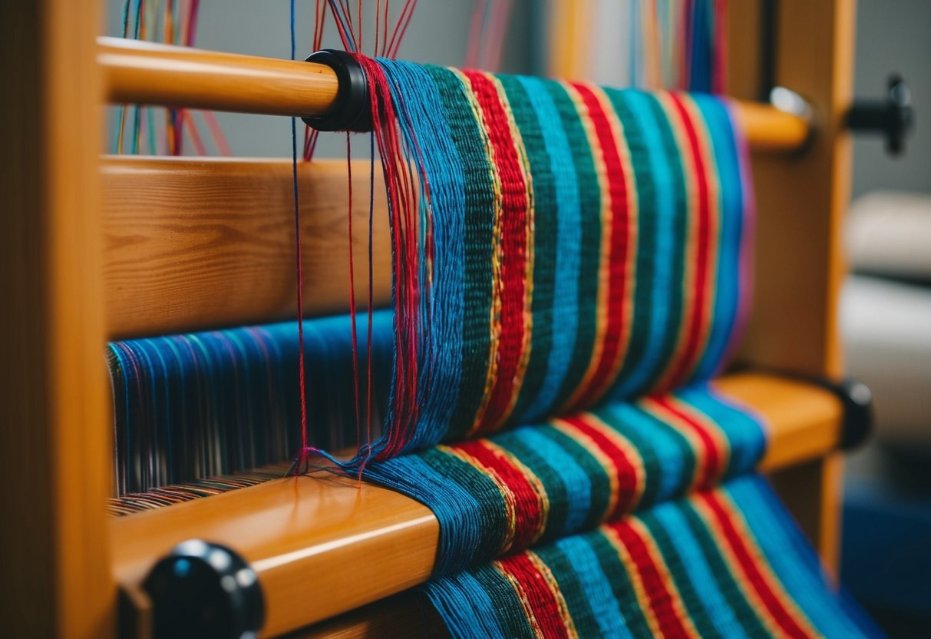Unraveling the technical distinctions and industry terminology to help you understand these commonly confused manufacturing concepts
Textiles and fabrics play a vital role in our daily lives, from the clothes we wear to the furnishings in our homes. Many people use these terms interchangeably, yet they have distinct meanings worth exploring. All fabrics are textiles, but not all textiles are fabrics – this simple distinction helps us understand their relationship.
Textiles encompass a broader category that includes raw fibres, yarns, and finished materials. Fabrics, on the other hand, are specific products made through weaving, knitting, or bonding these textile materials together. Think of textiles as the parent category and fabrics as one of its specialised forms.
The manufacturing process transforms raw textile materials into useful fabrics through various techniques. These methods have evolved over thousands of years, from basic hand-weaving to today’s advanced manufacturing technologies.
On This Page
Key Takeaways
- Textiles represent the broader category of fibre-based materials, while fabrics are finished products ready for use
- Manufacturing processes like weaving and knitting transform raw textile materials into functional fabrics
- Modern textile production combines traditional techniques with advanced technology to create sustainable materials
Defining Textiles and Fabrics
Textiles are materials made from fibres, whilst fabrics represent a specific type of textile created through weaving or knitting. The key difference lies in their scope and manufacturing processes.
Materials and Composition
All fabrics are textiles, but not all textiles are fabrics. Textiles encompass a broader range of materials, including leather, fur, and even certain plastics.
Natural materials like cotton, wool, and silk form the foundation of many textiles. These can be processed into yarns or used directly in textile production.
Synthetic materials like polyester and nylon offer unique properties that complement natural fibres. These materials often provide enhanced durability and specific performance characteristics.
Textile Fibres
Textile fibres come from three primary sources:
Plant-based fibres:
- Cotton
- Linen
- Hemp
- Jute
Animal-based fibres:
- Wool
- Silk
- Cashmere
- Mohair
Synthetic fibres:
- Polyester
- Nylon
- Acrylic
- Rayon
Each fibre type offers distinct properties that make them suitable for specific applications. Plant fibres typically provide breathability, whilst animal fibres offer warmth and insulation.
Fabric Types
Fabrics are created through specific manufacturing processes, primarily weaving and knitting. These methods determine the fabric’s properties and appearance.
Woven fabrics are made by interlacing yarns at right angles. Common examples include:
- Denim
- Canvas
- Twill
- Satin
Knit fabrics are created by interlocking loops of yarn. Popular types include:
- Jersey
- Rib knit
- Interlock
- Fleece
Non-woven fabrics like felt are made by bonding or felting fibres together without weaving or knitting.
Manufacturing Processes
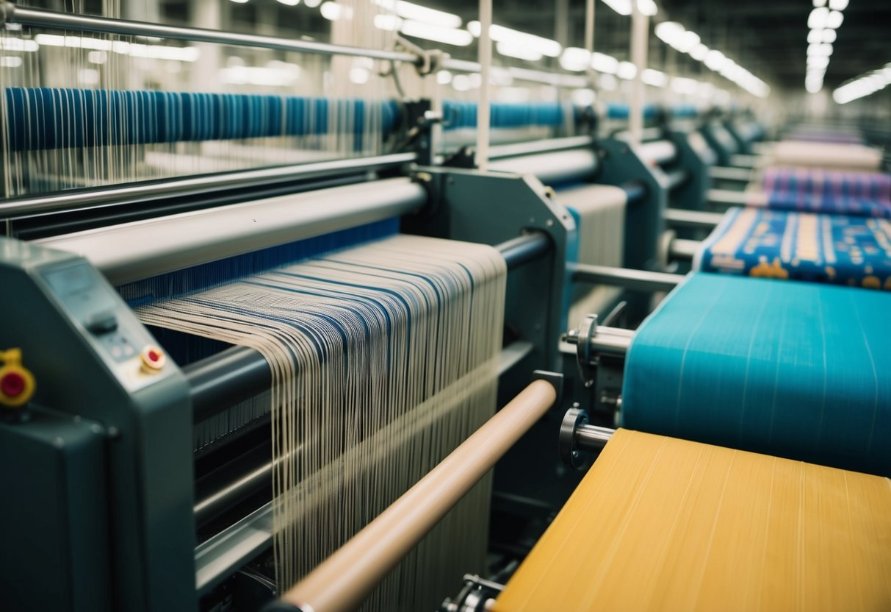
Textile manufacturing processes transform raw fibres into finished products through several specialised techniques. Each method creates unique material properties suited for different end uses.
Weaving and Knitting
Weaving creates fabric by interlacing two sets of yarn at right angles. The lengthwise yarns are called warp, while the crosswise yarns are called weft.
Modern weaving machines can produce hundreds of metres of fabric per hour. They use automated systems to control tension and pattern formation.
Knitting forms fabrics by creating interconnected loops of yarn. This technique produces stretchy, flexible materials perfect for clothing and accessories.
Two main types of knitting exist:
- Warp knitting: Multiple yarn strands form vertical columns
- Weft knitting: A single yarn creates horizontal rows
Non-Woven Fabric Production
Non-woven fabrics are created by bonding fibres together without weaving or knitting. This process is faster and more cost-effective than traditional methods.
The manufacturing involves three main steps:
- Web formation: Laying fibres in a sheet
- Web bonding: Using heat, chemicals, or mechanical pressure
- Finishing: Adding special treatments or coatings
Common applications include:
- Medical supplies
- Disposable hygiene products
- Industrial filters
- Geotextiles
Technical Textile Manufacturing
Technical textiles are engineered for specific functions rather than aesthetics. They require precise manufacturing processes to achieve their performance characteristics.
Advanced production methods include:
- Melt spinning for synthetic fibres
- Plasma treatment for enhanced durability
- Nanotechnology applications
These materials serve critical roles in:
- Protective clothing
- Aerospace components
- Medical implants
- Sports equipment
Quality control systems monitor every stage of production to ensure technical specifications are met.
The Role of Textiles in Fashion
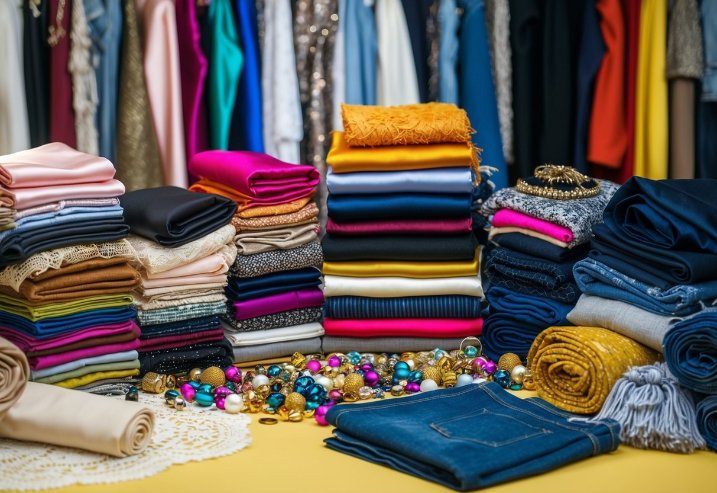
Textiles and fabrics form the foundation of clothing design and production. These materials shape how garments look, feel, and function in everyday wear.
Fashion Industry Needs
The fashion industry relies on diverse textile options to create clothing for different purposes. Natural and synthetic materials each serve specific functions in garment creation.
Designers select textiles based on several key factors:
- Durability for daily wear
- Comfort and breathability
- Cost-effectiveness in production
- Seasonal appropriateness
- Care requirements
Textile choices directly impact the final price of garments. Premium materials like silk and wool command higher prices, while synthetic blends offer more affordable options.
Trends and Material Choice
Fashion trends heavily influence textile selection in the clothing industry. Designers must balance current style preferences with practical considerations.
Popular textiles shift with each season. Summer collections favour light, breathable materials like cotton and linen. Winter fashion relies more on wool and heavier synthetic blends.
Specialised textiles serve specific fashion needs:
- Performance wear uses moisture-wicking synthetics
- Evening dresses often feature luxurious silks
- Casual wear typically incorporates cotton blends
Textile innovations continue to expand design possibilities. New sustainable materials and smart fabrics create fresh opportunities for creative expression in fashion.
Textile Applications
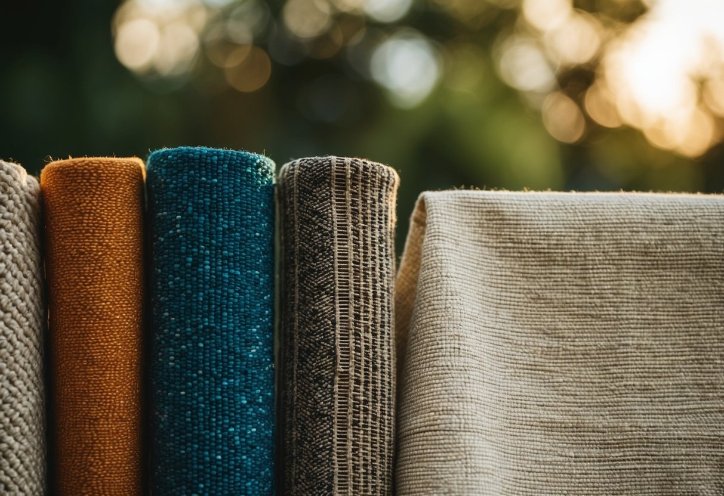
Textiles serve essential roles across multiple sectors, from enhancing living spaces to supporting critical infrastructure and medical care. These versatile materials offer unique properties that make them ideal for specialised functions.
Home and Interior Design
Textiles play a vital role in creating comfortable and functional living spaces. High-quality upholstery fabrics protect furniture while adding style and durability.
Window treatments like curtains and drapes control light and temperature while contributing to room aesthetics. These textiles often feature special coatings for UV protection and heat regulation.
Carpets and rugs provide insulation and noise reduction. Modern versions incorporate stain-resistant treatments and antimicrobial properties.
Wall coverings and decorative textiles add texture and visual interest. These include tapestries, wall hangings, and acoustic panels that help control room acoustics.
Industrial and Technical Uses
Industrial textiles serve demanding environments where strength and durability are crucial. Conveyor belts use reinforced textiles to transport heavy materials in manufacturing and mining.
Automotive textiles create vehicle interiors that resist wear and maintain appearance. These materials must meet strict safety standards for flame resistance.
Protective clothing uses specialised textiles to guard against heat, chemicals, and electrical hazards. These garments often combine multiple layers for maximum protection.
Medical and Geotextile Functions
Medical textiles create sterile environments in healthcare settings. Surgical gowns, masks, and bandages use antimicrobial fibres to prevent infection spread.
Geotextiles strengthen soil structures in construction projects. These materials prevent erosion and improve drainage in roads and railways.
Filter textiles purify air and water in industrial processes. Their precise pore sizes trap specific particles while allowing fluid flow.
Wound care products use advanced textiles that promote healing. These materials can release medications and maintain proper moisture levels.
Properties of Textiles and Fabrics
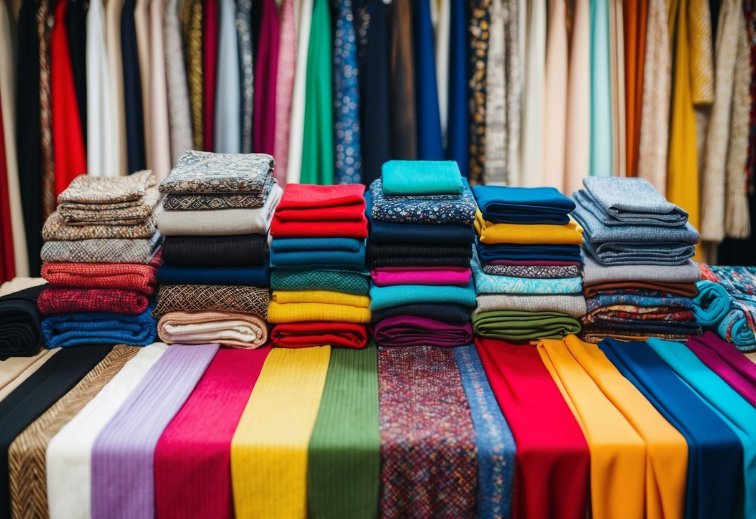
Physical properties of textiles and fabrics determine their performance, comfort and care requirements. These characteristics affect how materials feel against the skin and how well they hold up during use.
Durability and Maintenance
Different textile materials require specific care methods to maintain their quality. Natural fibres like cotton need gentle washing in warm water, while synthetic materials often withstand higher temperatures.
Strong fibres and tight weaves create durable fabrics that resist wear and tear. Nylon and polyester show excellent strength, making them ideal for activewear and outdoor gear.
Regular maintenance extends the life of textiles. Proper washing, drying and storage prevent damage like shrinkage, fading and fabric pill formation.
Texture and Comfort
Felted fabrics offer different thicknesses and textures, while woven materials can range from smooth to rough. Silk feels smooth and cool, whilst wool provides warmth with a slightly coarse texture.
The weight of a fabric affects its drape and comfort level. Lightweight materials like cotton voile flow easily, while heavier fabrics like denim hold their shape.
Stretch and flexibility vary between materials. Knitted fabrics offer natural elasticity, making them perfect for close-fitting garments.
Breathability and Moisture-Wicking
Natural fibres like cotton and wool excel at moisture absorption. They pull sweat away from the skin, helping regulate body temperature during physical activity.
Synthetic materials often feature special treatments to enhance their moisture-wicking abilities. These treatments help move moisture to the fabric’s outer surface for quick evaporation.
Some fabrics combine natural and synthetic fibres to maximise performance. This creates materials that offer both comfort and effective moisture management.
Air permeability varies between different textile structures. Loose weaves and knits allow better airflow than tightly woven fabrics.
Environmental Considerations and Sustainability

The textile industry faces significant environmental challenges from raw material sourcing through production. Sustainable fabric alternatives and improved manufacturing processes offer promising solutions to reduce ecological impact.
Eco-Friendly Materials
Natural fibres like organic cotton, hemp, and linen require fewer chemicals and water to produce compared to conventional materials. Wool textiles provide inherent sustainability benefits through biodegradability and minimal processing needs.
Recycled synthetic fibres made from plastic bottles and other waste materials help reduce landfill waste. These materials use up to 50% less energy to produce than virgin synthetics.
Innovative plant-based alternatives like bamboo and eucalyptus-derived fibres offer renewable options. These materials grow quickly without pesticides and need minimal irrigation.
Sustainability in Production
Modern eco-friendly production methods use closed-loop systems to recycle water and chemicals. This approach reduces waste and prevents water pollution.
Energy-efficient machinery and renewable power sources lower carbon emissions in textile manufacturing. LED lighting and heat recovery systems cut energy use by 30-40%.
Natural dyes and low-impact finishing processes reduce chemical pollution. Water-based dyes and enzyme treatments replace harsh chemicals traditionally used in fabric processing.
Digital printing technologies minimise water usage and chemical waste compared to traditional methods. These systems use up to 95% less water than conventional printing.
The Evolution of Textile Techniques
Textile techniques have transformed from basic hand-weaving to complex automated systems, shaping the way we produce fabrics and clothing today.
Historical Overview
Ancient textile production began with simple hand-weaving techniques using natural fibres like wool, cotton, and silk. People created basic looms to weave threads into fabric.
Early civilisations mastered different weaving patterns and developed specialised tools for spinning yarn. The spinning wheel revolutionised yarn production in the 11th century.
Medieval craftsmen introduced complex weaving techniques, creating intricate patterns and designs. They used both plain weave and twill weave methods.
Knitting emerged as a valuable technique during the Middle Ages. People used wooden needles to create flexible, warm garments.
Modern Innovations
The Industrial Revolution transformed textile production with mechanical looms and spinning machines. These innovations increased production speed and consistency dramatically.
Modern textile manufacturing uses computerised systems to control:
- Pattern creation
- Weaving speed
- Tension control
- Quality monitoring
New techniques like 3D knitting create seamless garments in a single process. Smart textiles incorporate electronic components for enhanced functionality.
Digital printing allows for precise pattern application, while advanced felting methods create durable non-woven fabrics.
Textiles and Consumer Choices
The choice between different textiles impacts both immediate purchasing costs and long-term maintenance expenses. Careful consideration of these factors helps buyers make informed decisions about their textile investments.
Cost and Availability
Synthetic fabrics are widely available and typically cost less than natural materials. Their production can be controlled to ensure steady market supply.
Natural fibres often command higher prices due to limited growing seasons and environmental factors that affect production.
Different textile types suit various budgets:
- Basic synthetics: £5-15 per metre
- Cotton blends: £10-25 per metre
- Pure wool: £20-50 per metre
- Luxury silk: £30-100+ per metre
Care and Maintenance Requirements
Each textile type needs specific care to maintain its quality. Natural fibres like cotton and wool may shrink or stretch without proper washing techniques.
Common Care Requirements:
- Synthetics: Machine washable, quick-drying
- Cotton: Warm wash, medium heat drying
- Wool: Hand wash or dry clean only
- Silk: Professional cleaning recommended
Regular maintenance helps extend the life of textiles. Proper storage prevents moth damage in natural fibres and colour fading in synthetics.
Following care labels saves money by preventing damage and extending the textile’s lifespan.
Frequently Asked Questions
Textile and fabric differences involve specific manufacturing methods, raw materials, and end uses across the clothing and manufacturing industries. Common questions arise about cotton processing, material classification, and production techniques.
What distinguishes textiles from fabric in clothing manufacturing?
Textiles encompass all materials from fibre to finished fabric, whilst fabrics represent the end product created through specific manufacturing techniques like weaving or knitting.
Fabrics must go through precise construction processes to transform from raw textile materials into useable products. These processes include weaving, knitting, and non-woven techniques.
How does cotton relate to textiles and fabrics?
Cotton serves as a primary natural fibre in textile production. When raw cotton is processed, it becomes a textile material.
The cotton textile then transforms into fabric through weaving or knitting processes. This makes cotton both a textile in its processed form and a component of finished fabrics.
Could you provide some examples of materials classed as textiles?
Plant-based textiles include cotton, hemp, and jute. Animal-based options feature wool and silk.
Synthetic textiles comprise polyester, nylon, and acrylic materials. Each type offers unique properties for different applications.
What constitutes a textile in the context of material production?
A textile includes any product or process from fibre to fabric creation. This encompasses raw materials, yarns, and threads.
Textiles form the foundation for fabric production but can also exist as standalone materials like rope or yarn.
In what ways do fabric and cloth differ from one another?
Fabric serves as the raw material used to produce finished cloth items. Cloth typically refers to the completed product ready for use.
Fabric requires additional processing steps to become cloth, such as cutting, sewing, or finishing treatments.
Where might one typically find a wide variety of textiles and fabrics?
Textile wholesalers and fabric shops stock extensive selections of materials. Manufacturing facilities maintain inventories of industrial textiles.
Fashion design studios and garment factories use diverse textile collections. Home furnishing retailers offer decorative and upholstery fabrics.

